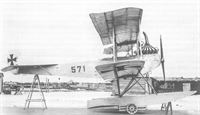
Описание
Страна: Германия
Год: 1915
O.Thetford, P.Gray German Aircraft of the First World War (Putnam)
Brandenburg LW
Delivered in May 1916, the only LW built (No. 577) was claimed by Heinkel to be the first reconnaissance seaplane to be designed with a defensive gun, which statement is open to grave doubt. The redoubtable Heinkel claimed most of his designs as being the first, the best or the biggest! From the distinctive stagger and inward rake of the interplane struts, it is obvious the machine stemmed from the C I land machine built for Austro-Hungary. Engine, 160 h.p. Mercedes D III. Span, 12.4 m. (40 ft. 8 1/4 in.). Length, 9.5 m. (31 ft. 2 1/8 in.). Area, 42.6 sq.m. (460 sq.ft.). Weights: Empty, 994kg.(2.187lb.). Loaded, 1,555kg.(3,421 lb.). Speed, 130 km.hr. (81.25 m.p.h.). Climb, 1,000 m. (3,280 ft.) in 12 min. Armament, one Parabellum machine-gun.
Описание:
- O.Thetford, P.Gray German Aircraft of the First World War (Putnam)
- C.Owers Hansa-Brandenburg Aircraft of WWI Vol.2: Biplane Seaplanes (A Centennial Perspective on Great War Airplanes 18)
- M.Dusing German Aviation Industry in WWI. Volume 1 (A Centennial Perspective on Great War Airplanes 84)
Фотографии
-
A.Imrie - German Naval Air Service /Arms & Armour/
Brandenburg W477, its 160hp Mercedes engine running, is lifted off its railway car by crane and swung out to clear the Zeebrugge Mole prior to being lowered into the water. The observer, who was responsible for the correctness of the lifting shackle, is standing on the edge of his cockpit ready to release the crane's hook when lowering is complete. The Rating (extreme right) walking away with the tail line prevents the aircraft from turning out of wind while suspended from the crane. Containers for fuel, oil and water can be seen on the railway car.
-
A.Imrie - German Naval Air Service /Arms & Armour/
Brandenburg W477 moving away from Zeebrugge Mole after having been lowered by crane to the water. Depending on the wind speed and direction, sometimes full deflection of the control surfaces was needed in order to 'sail' the seaplane in the desired direction, especially if taxiing downwind, as here. This machine was based at Zeebrugge from September 1915 and took part in several bombing raids against the United Kingdom, usually crewed by Leutnants Rolshoven (pilot) and von Frankenburg (observer).
-
C.Owers - Hansa-Brandenburg Aircraft of WWI. Volume 2 - Biplane Seaplanes /Centennial Perspective/ (18)
LW Marine Number 571. Note the machine gun mount in the rear cockpit and the slinging cable on the top wing center section.
-
C.Owers - Hansa-Brandenburg Aircraft of WWI. Volume 2 - Biplane Seaplanes /Centennial Perspective/ (18)
LW MN 571. Note the machine gun mount in the rear cockpit and the slinging cable on the top wing centre section.
-
C.Owers - Hansa-Brandenburg Aircraft of WWI. Volume 2 - Biplane Seaplanes /Centennial Perspective/ (18)
NW 571 leads this line-up of six floatplanes under construction.
-
C.Owers - Hansa-Brandenburg Aircraft of WWI. Volume 2 - Biplane Seaplanes /Centennial Perspective/ (18)
Brandenburg Type LW Factory Drawing









